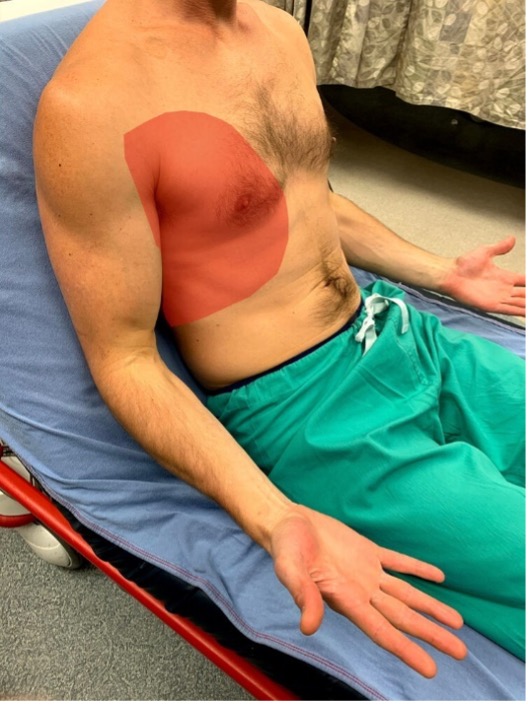A 72-year-old male presents to the emergency department (ED) with severe chest pain and difficulty breathing after an MVC. Physical examination reveals tenderness and localized swelling over the left lateral chest wall, with X-ray confirming multiple rib fractures. The patient’s vital signs are stable, but he is visibly distressed and struggling to find a comfortable position.
What are nerve blocks?
Nerve blocks involve administering local anesthetic near specific nerves to block pain signals and provide targeted pain relief. They are used for various purposes in pain management and anesthesia.1
Why is the serratus anterior plane block (SAPB) superior to other analgesic methods?
It is important to note that pain is not only a symptom, impact on respiratory function and the occurrence of cardiovascular complications are the principles causes of complications from rib fractures.2 Although a stepwise approach to pain management involving anti-inflammatories, opioids, and sedation is reasonable, it is often insufficient for patients with multiple rib fractures. Moreover, in elderly patients, the potential side effects of opioids, such as respiratory depression, impaired cough reflex, and delirium, raise concerns.3 Therefore, an opioid-sparing approach that integrates regional anesthesia is believed to be optimal for patients. Additionally, while epidural analgesia is recommended by trauma guidelines, it is not readily available in the ED.4 Intercostal nerve blocks on the other hand can be technically challenging, resource-intensive, and often require multiple injections.5 As a result, the serratus anterior plane block (SAPB) has emerged as a superior approach for analgesia of rib fractures in the ED setting.6
Indications and contraindications
In the ED setting, the SAPB is indicated for analgesia in all of the following: rib fractures, rib contusions and thoracotomies.6 Contraindications include but are not limited to allergies to local anesthetics, infection at the injection site, bleeding disorders, or patient refusal.6
SABP procedure
- Patient is placed in either a lateral decubitus or supine position.
- Ultrasound transducer is positioned in the midaxillary line at the level of the fifth rib, with the probe marker facing the nipple. Landmarks of the hyperechoic ribs, pleural line, serratus anterior muscle, and latissimus dorsi muscle are identified.
- Needle is inserted in-plane, and once the needle tip is positioned just above the serratus anterior muscle, anesthetic solution is injected to open the fascial plane. The goal is to deposit a large volume of dilute anesthetic in the fascial plane, allowing anesthetic to spread and anesthetize the lateral cutaneous branches of the thoracic intercostal nerves.7


Need a deeper dive into the procedure? Watch the following video demonstration of the SAPB block:
Complications and limitations
Complications of SAPB include but are not limited to pneumothorax, infection, nerve injury and local anesthetic-related complications.6 Of note, the duration of pain relief from a single nerve block may be limited to 6-8 hours using bupivacaine, requiring repeated blocks.6 Although the SAPB provided excellent coverage for superficial procedures, it may be not reliable as the sole anesthesia for deeper procedures such as thoracostomy tube placement mainly due to possibly inconsistent spread of anesthetic to the intercostal nerve-roots.9
Case conclusion
Now let’s apply what we’ve learnt to our 72-year-old male who presents to the ED after an MVC with multiple rib fractures. In the context of this elderly patient who is at higher risk of pulmonary complications,10 effective pain management is crucial. The SAPB in this elderly male provides a simple, targeted approach for pain control without the sequelae of opioids, along with improved respiratory function in the ED setting.
While this article focuses on the SAPB, by understanding the strengths and weaknesses of different analgesic techniques, the clinician can weigh the risks and benefits and individualize pain management based on the clinical setting and the extent of trauma.
This post was copyedited by @aafia-maqsood and was edited by Daniel Ting.
References
- 1.Leng C, Rosenblatt M. Overview of peripheral nerve blocks . UpToDate. Published August 7, 2023. Accessed July 1, 2023. https://www.uptodate.com/contents/overview-of-peripheral-nerve-blocks
- 2.Zhe H, Dongsheng Z, Haiping X, et al. The ideal methods for the management of rib fractures. Journal of Thoracic Disease. 2019;8. doi:10.21037/jtd.2019.04.109
- 3.Bergeron E, Lavoie A, Clas D, et al. Elderly Trauma Patients with Rib Fractures Are at Greater Risk of Death and Pneumonia. The Journal of Trauma: Injury, Infection, and Critical Care. Published online March 2003:478-485. doi:10.1097/01.ta.0000037095.83469.4c
- 4.Simon BJ, Cushman J, Barraco R, et al. Pain Management Guidelines for Blunt Thoracic Trauma. The Journal of Trauma: Injury, Infection, and Critical Care. Published online November 2005:1256-1267. doi:10.1097/01.ta.0000178063.77946.f5
- 5.Ho B, Buck R, Latmore M, Levine M, Karmakar M. Intercostal Nerve Block – Landmarks and Nerve Stimulator Technique. NYSORA. Accessed July 1, 2023. https://www.nysora.com/topics/regional-anesthesia-for-specific-surgical-procedures/thorax/intercostal-nerve-block/
- 6.Southgate S, Herbst M. Ultrasound-Guided Serratus Anterior Blocks. statpearls. Published online July 25, 2022. http://www.ncbi.nlm.nih.gov/books/NBK538476/
- 7.Nagdev A, Mantuani D, Durant E, Herring A. Ultrasound-Guided Serratus Anterior Plane Block Can Help Avoid Opioid Use for Patients with Rib Fractures . ACEP Now. Published March 14, 2017. Accessed July 1, 2023. https://www.acepnow.com/article/ultrasound-guided-serratus-anterior-plane-block-can-help-avoid-opioid-use-patients-rib-fractures/?singlepage=1
- 8.Damm T. Thoracoabdominal Blocks. The Pocus Atlas. Accessed July 1, 2023. https://www.thepocusatlas.com/thoracoabdominal-blocks#Serratus
- 9.Durant E, Dixon B, Luftig J, Mantuani D, Herring A. Ultrasound-guided serratus plane block for ED rib fracture pain control. The American Journal of Emergency Medicine. Published online January 2017:197.e3-197.e6. doi:10.1016/j.ajem.2016.07.021
- 10.Elmistekawy E, Hammad AA. Isolated rib fractures in geriatric patients. Ann Thorac Med. Published online 2007:166. doi:10.4103/1817-1737.36552
Reviewing with the staff
Rib fractures can lead to significant complications, affecting respiratory function and hemodynamic stability, particularly in elderly patients. The use of nerve blocks, such as the serratus anterior plane block (SAPB), offers a promising and effective approach to pain control in the ED setting. The article emphasizes an opioid-sparing strategy aligns well with the current focus on minimizing opioid use and its potential adverse effects, especially in vulnerable populations like the elderly. Understanding and implementing such nerve blocks can significantly improve patient outcomes. The SAPB block provides targeted pain relief and enhanced respiratory
function, ultimately leading to better overall care and patient satisfaction in the emergency department.



